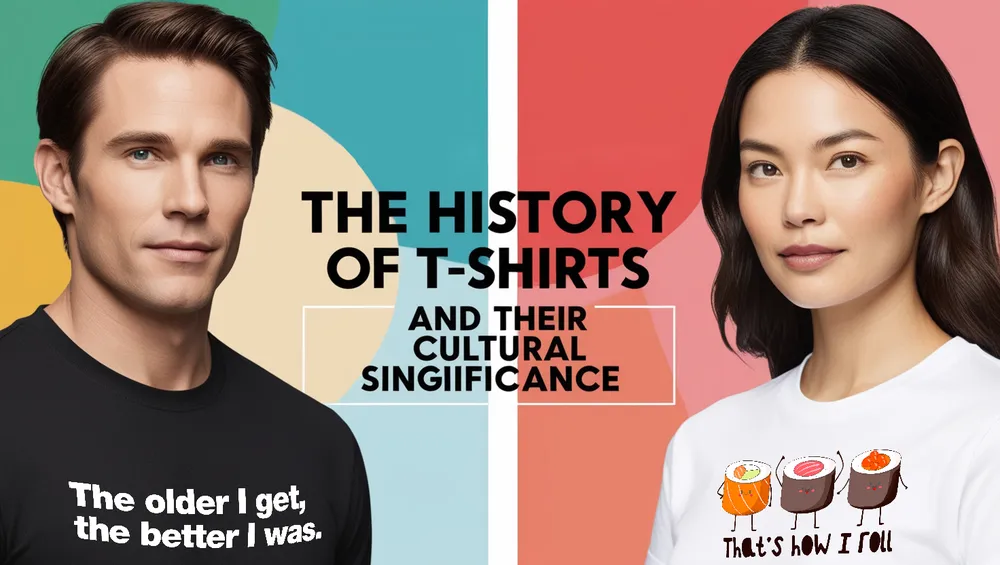No products in the cart.
T-Shirt Knowledge and Trends
The History of T-Shirts and Their Cultural Significance
T-shirts have become a staple in wardrobes across the globe, evolving from humble beginnings as basic undergarments to powerful symbols of identity, rebellion, and cultural significance. This article delves into the history of T-shirts, tracing their development over the years and examining their profound impact on culture, fashion, and personal expression.
The Origins of T-Shirts
The history of T-shirts can be traced back to the late 19th century. Initially, T-shirts were designed as undergarments, serving a practical purpose rather than a fashion statement. Made from lightweight cotton, they were comfortable and functional, catering primarily to laborers and soldiers.
The Late 19th Century: The Birth of the T-Shirt
The first T-shirts were simple, utilitarian garments resembling a short-sleeve, crew-neck shirt. They were primarily worn under uniforms, providing comfort for those in physically demanding jobs. As industries expanded, the need for practical clothing grew, leading to the production of these simple cotton shirts.
Early 20th Century: Military Influence
During World War I, the U.S. military recognized the utility of T-shirts as standard issue undergarments for soldiers. The lightweight and breathable fabric allowed for greater mobility and comfort in the trenches. Soldiers returning home after the war brought these comfortable garments with them, introducing T-shirts to civilian life.
By the 1930s, T-shirts began to be marketed as standalone garments. Companies produced them in various colors and prints, appealing to a broader audience and setting the stage for the T-shirt’s transformation into a fashion item. Learn more about the historical evolution of T-shirts on Wikipedia.
The 1950s: The Cultural Shift
The 1950s marked a turning point in the history of T-shirts. Hollywood icons such as Marlon Brando and James Dean popularized T-shirts as fashion statements. Their portrayals of rebellious youth in films like A Streetcar Named Desire and Rebel Without a Cause featured T-shirts prominently, establishing a cultural connection between T-shirts and youth rebellion. This era laid the groundwork for T-shirts to become synonymous with individual expression.
T-Shirts as a Medium for Expression
As the decades progressed, T-shirts evolved into powerful tools for personal and political expression. The cultural significance of T-shirts surged during the 1960s and 1970s, driven by the counterculture movement. Activists and artists began to use T-shirts as canvases for self-expression, reflecting the societal upheavals of the time.
The Counterculture Movement
During the 1960s, T-shirts became symbols of the counterculture movement, which sought to challenge traditional norms and promote social change. Young people adorned their T-shirts with slogans advocating for peace, civil rights, and gender equality. The use of graphics and slogans on T-shirts became a way to voice dissent and promote awareness of various causes.
Iconic T-Shirt Designs
As the counterculture movement gained momentum, iconic T-shirt designs emerged, often featuring slogans and graphics that resonated with the times. The famous “peace” symbol became a staple on T-shirts worn by anti-war activists during the Vietnam War. Similarly, T-shirts promoting feminism and civil rights proliferated, reinforcing the idea that clothing could serve as a vehicle for social change.
T-Shirts and Music Culture
The connection between T-shirts and music culture also flourished during this period. Rock and punk musicians began using T-shirts to promote their music and establish their identities. Limited-edition concert tees became highly sought after, with fans wearing them as badges of honor. The rise of bands like The Rolling Stones, The Ramones, and The Sex Pistols popularized the idea of wearing T-shirts as a means of expressing musical allegiance.
For a deeper exploration of this connection, check out our article on the Influence of Music on T-Shirt Designs.
The Globalization of T-Shirt Culture
As we moved into the 1980s and beyond, the history of T-shirts saw a shift towards globalization. The accessibility of T-shirts as fashion items expanded rapidly, with brands from around the world producing unique designs. The rise of screen printing technology allowed for vibrant graphics and innovative designs, making T-shirts a versatile canvas for artistic expression.
Custom T-Shirts: The New Frontier
The advent of custom T-shirts further transformed the T-shirt landscape. Individuals could now design their own T-shirts, incorporating personal messages, artwork, or photographs. This customization trend democratized fashion, enabling people to create clothing that resonated with their identities.
The Role of Technology
Advancements in technology played a crucial role in the custom T-shirt revolution. Digital printing methods made it easier and more cost-effective for individuals and small businesses to produce custom designs. Online platforms emerged, allowing users to create and order personalized T-shirts from the comfort of their homes.
If you’re interested in understanding the technology behind custom T-shirts, our article on Understanding T-Shirt Printing provides valuable insights.
T-Shirts in the Digital Age
The rise of social media has amplified the significance of T-shirts in contemporary culture. Platforms like Instagram and TikTok have turned T-shirts into trending fashion items, with influencers showcasing their unique designs to a global audience. Custom T-shirts featuring catchy slogans, graphics, or pop culture references can go viral, leading to rapid trends that capture the attention of consumers.
The Symbolism of T-Shirts
T-shirts carry rich symbolism that extends beyond their fabric. They can represent belonging to a group, showcase support for a cause, or simply reflect personal style. Whether worn at charity events, music festivals, or casual outings, T-shirts signify unity and shared values.
T-Shirts in Social Movements
Throughout history, T-shirts have played crucial roles in various social movements. Activists have used them to raise awareness, promote causes, and inspire action. The black T-shirt featuring the phrase “Black Lives Matter” has become a symbol of the fight against systemic racism, while the pink “pussyhat” T-shirt became synonymous with the Women’s March in 2017.
The Impact of Graphic T-Shirts
Graphic T-shirts have emerged as a powerful means of communication. They often feature eye-catching designs that convey complex messages in a simple, digestible format. These shirts can spark conversations, provoke thought, and inspire action. For example, T-shirts with environmental messages have gained popularity as awareness of climate change has increased, urging individuals to take action for a sustainable future.
The Future of T-Shirts
As we look to the future, the history of T-shirts continues to unfold. Innovations in sustainable materials and ethical production practices are shaping the next generation of T-shirts. Consumers are increasingly conscious of their purchasing choices, favoring brands that prioritize environmental sustainability and social responsibility.
Sustainable Fashion and Ethical Practices
The fashion industry has faced significant scrutiny for its environmental impact. In response, many T-shirt brands are adopting sustainable practices, utilizing organic cotton, recycled materials, and eco-friendly dyes. This shift towards sustainability reflects a growing consumer demand for products that are not only stylish but also environmentally conscious.
For insights into choosing fabrics for T-shirts, you can refer to our guide on Choosing the Right Fabric for T-Shirts.
Conclusion
The history of T-shirts is a testament to their cultural significance. From their origins as basic undergarments to their status as symbols of fashion and self-expression, T-shirts have evolved alongside societal changes. They continue to inspire creativity and individuality, making them an enduring element of modern culture. As the fashion landscape shifts toward sustainability, T-shirts will undoubtedly adapt, maintaining their relevance in a changing world.
Q&A Section
Q1: What is the origin of the T-shirt?
A1: The T-shirt originated as an undergarment in the late 19th century and became popularized by U.S. Navy sailors during World War II.
Q2: How have T-shirts influenced pop culture?
A2: T-shirts became fashion statements in the 1950s, popularized by Hollywood stars, and have since been used to express rebellion, identity, and political views.
Q3: What are some iconic T-shirt designs?
A3: Iconic designs include concert tees, slogan shirts, and those featuring pop culture references, often used to convey messages or promote causes.
Q4: How do T-shirts symbolize social movements?
A4: T-shirts often carry slogans and graphics representing social and political causes, making them tools for advocacy and unity.
Q5: What are the benefits of custom T-shirts?
A5: Custom T-shirts allow individuals to express their unique identities and promote personal or organizational messages, making them versatile fashion choices.
Explore our diverse collection of custom T-shirts at Capital T-Shirt, where you can choose from various designs and styles that resonate with your personality. Whether you’re looking for a unique statement piece or a gift for a loved one, we have something for everyone!




Related Posts: